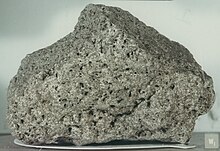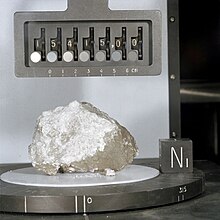Lunar basalt 70017 returned by Apollo 17
Lunar sample 15415, also known as the "Genesis Rock"
Most atoms on Earth came from the interstellar dust and gas from which the Sun and Solar System formed. However, in the space science community, "extraterrestrial materials"
generally refers to objects now on Earth that were solidified prior to
arriving on Earth. In October 2011, scientists reported that one form
of extraterrestrial material, cosmic dust, contains complex organic matter ("amorphous organic solids with a mixed aromatic-aliphatic structure") that could be created naturally, and rapidly, by stars. In February 2014, NASA announced a greatly upgraded database for tracking polycyclic aromatic hydrocarbons (PAHs) in the universe. According to scientists, more than 20% of the carbon in the universe may be associated with PAHs, possible starting materials for the formation of life. PAHs seem to have been formed shortly after the Big Bang, are widespread throughout the universe, and are associated with new stars and exoplanets.
Categories
To date these fall into a small number of broad categories, namely:
- Meteorites too large to vaporize on atmospheric entry but small enough to leave fragments lying on the ground
- Moon rocks brought to Earth by the Apollo and Luna missions
- Unmelted micrometeorites typically less than 100 micrometres in diameter collected on Earth and in the Earth's stratosphere
- Specimens returned from space-borne collection missions like NASA's Long Duration Exposure Facility (LDEF) and the Stardust sample return mission.
A minor but notable subset of the materials that make up the foregoing collections were also solidified outside of the Solar System. These are often referred to as interstellar materials, some of which are also presolar i.e. they predate the formation of the Solar System.
Each of these types of material is treated elsewhere. This
entry, therefore, is here primarily to consider the relationship between
types of extraterrestrial materials on Earth, as well as the types of
extraterrestrial material we'd like to have a closer look at.
Special characteristics
Oxidation state
Thanks to the "romance" between carbon and oxygen atoms, which form gases when they combine, the solid material in a given planetary system
probably depends on whether carbon abundances were greater, or less,
than those of oxygen. What is left over goes into solids. There was more
oxygen than carbon in the Solar System, so solid planetary surfaces (as
well as primitive meteorites) are largely made up of oxides like SiO2 (silicates, resulting in silicate planets). If the converse was true, carbides might be the dominant form of "rock" (resulting in carbon planets).
Larger planetary bodies in the early Solar System were hot enough to experience melting and differentiation, with heavier elements (like nickel) finding their way into the core. The lighter silicate rocks presumably float to the surface. Thus this might explain why iron on Earth's surface is depleted in nickel, while iron meteorites (from the center of a differentiated planetoid) are rich in nickel. Since it is not a very active rock-forming element, most of our nickel is in the Earth's core.
A key feature of extraterrestrial materials, in comparison to naturally
occurring terrestrial materials, is therefore Ni/Fe ratios above
several percent.
Another consequence of the leftover oxygen in the early Solar System is the fact that presolar carbides from star systems
with higher ratios of C/O are easier to recognize in primitive
meteorites, than are presolar silicates. Hence presolar carbon and
carbide grains were discovered first.
Elemental abundances
Present
day elemental abundances are superimposed on an (evolving)
galactic-average set of elemental abundances that was inherited by the
Solar System, along with some atoms from local nucleosynthesis sources, at the time of the Sun's formation. Knowledge of these average planetary system elemental abundances is serving as a powerful tool for tracking chemical and physical processes involved in the formation of planets, and the evolution of their surfaces. Awaiting more on this here cf. cosmic abundance.
Impact and irradiation effects
The
atmosphere of planet Earth, and the Earth's magnetic field, protect us
from impact and irradiation by a wide range of objects that fly around
in space. Those who know about these effects can often learn from them a
lot about the history of extraterrestrial materials.
Microcraters and such
Microcraters, "pancakes", and "splashes" were first seen on the surface of lunar rocks and soil
grains. They tell us about the direct exposure of an object's surface
to space in the absence of an atmosphere. These structures are quite
unlike features found on the surface of terrestrial rocks and soil.
They have also been identified on grains found in meteorites, and on
man-made objects exposed to the micrometeorite flux in space.
Nuclear particle tracks
Nuclear
track damage trails from the passage of heavy ions in non-conducting
solids were first reported by E. C. H. Silk and R. S. Barnes in 1959. Their etchability along with many subsequent applications were established by Fleischer, Price and Walker, starting with their work at General Electric Laboratories in Schenectady, New York.
Nuclear particle tracks subsequently found many uses in
extraterrestrial materials, thanks both to the exposure of those
materials to radiation in space, and to their sometimes ancient origins.
These applications included (i) determining the exposure of mineral
surfaces to solar flare
particles from the Sun, (ii) determining the spectrum of solar flare
particle energies from the early Sun, and (iii) the discovery of fission
tracks from extinct isotopes of Plutonium 244 in primitive meteorites.
Nuclear spallation effects
Particles
subject to bombardment by sufficiently energetic particles, like those
found in cosmic rays, also experience the transmutation of atoms of one
kind into another. These spallation
effects can alter the trace element isotopic composition of specimens
in ways which allow researchers in the laboratory to fingerprint the
nature of their exposure in space.
These techniques have been used, for example, to look for (and
determine the date of) events in the pre-Earth history of a meteorite's
parent body (like a major collision) that drastically altered the space
exposure of the material in that meteorite. For example, the Murchison meteorite landed in Australia in 1967, but its parent body apparently underwent a collision event about 800,000 years ago which broke it into meter-sized pieces.
Isotopic abundances
The isotopic homogeneity of our planet and the Solar System provides a blank slate on which to detect the effect of nuclear processes on Earth, in the Solar System, and in objects coming to us from outside the Solar System. Awaiting more here, see natural abundance.
Noble gases
Noble gases
are particularly interesting from an isotopic perspective, first
because they avoid chemical interactions, secondly because many of them
have more than one isotope on which to carry the signature of nuclear
processes (xenon
has many), and finally because they are relatively easy to extract from
solid materials by simple heating. As a result, they play a pivotal
role in the unfolding drama of extraterrestrial materials study.
Some clues to moving further might be found in this book and this article.
Radiometric dating in general
Isotopic
abundances provide important clues to the date of events that allowed a
material to begin accumulating gaseous decay byproducts, or that
allowed incident radiation to begin transmuting elements. Because of
the harsh radiations, unusual starting compositions, and long delays
between events sometimes experienced, isotopic dating techniques are of
special importance in the study of extraterrestrial materials.
Until more perspective is added here on the importance of these
tools to extraterrestrial materials research, you can find clues to some
strategies not mentioned here under radiometric dating.
Other isotopic studies
The
categories of study mentioned before this are classic isotopic
applications. However, extraterrestrial materials also carry
information on a wide range of other nuclear processes. These include
for example: (i) the decay of now-extinct radionuclides, like those supernova byproducts introduced into Solar System materials shortly before the collapse of our solar nebula, and (ii) the products of stellar and explosive nucleosynthesis found in almost undiluted form in presolar grains. The latter are providing astronomers with up-close information on the
state of the whole periodic table in exotic environments scattered all
across the early Milky Way.


